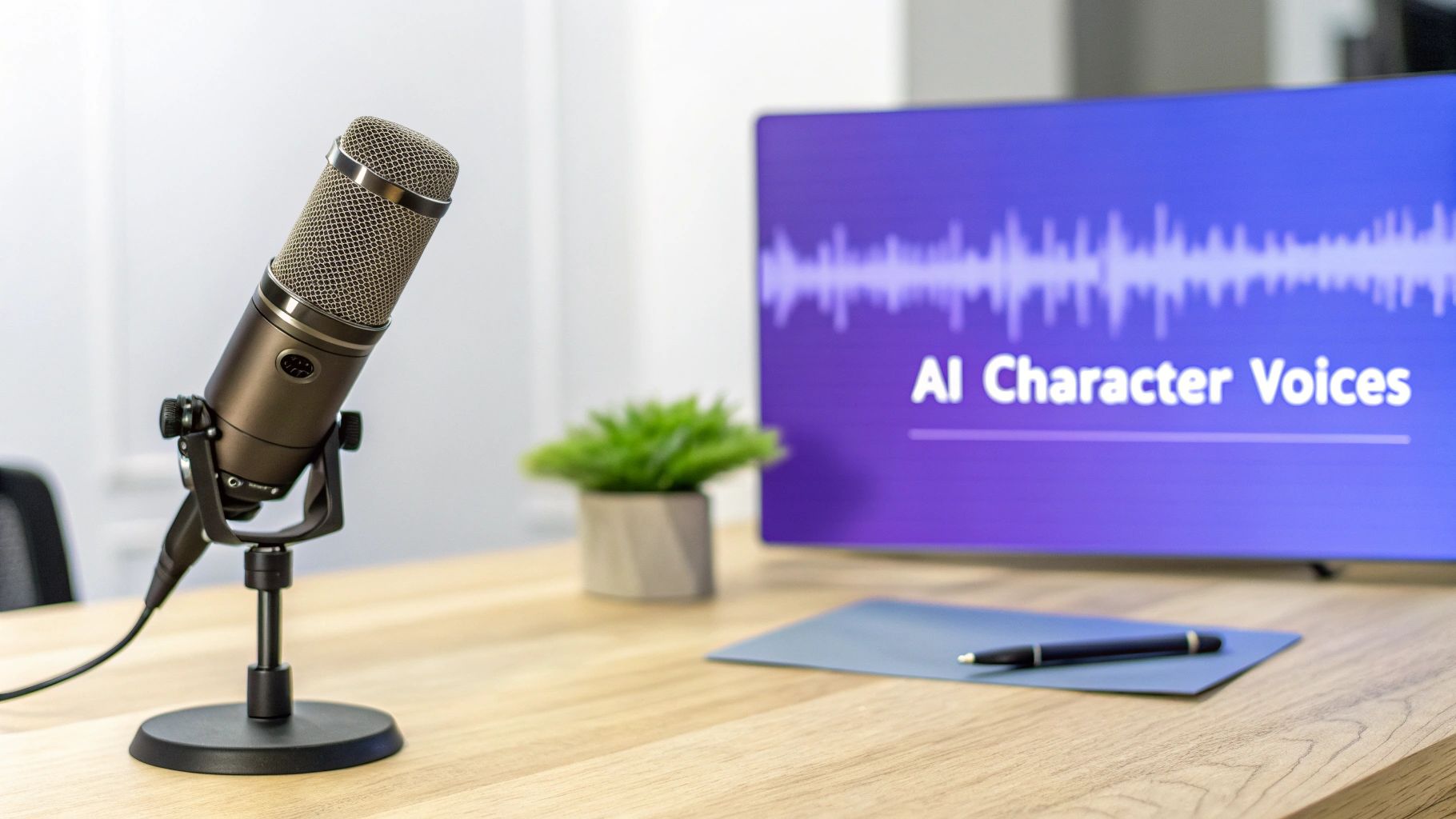You’ve probably heard those robotic, monotone text-to-speech voices before. You know the ones—they get the words right, but something just feels…off. AI character voices are the complete opposite. Think of them as digital actors for your audio content, built to deliver performances that actually connect with people.
What Are AI Character Voices

At its heart, an AI character voice is a synthetic voice crafted to embody a specific persona. It’s not just about reading words on a page; it’s about performing them. These voices are packed with unique emotions, tones, and speaking styles that bring a script to life.
Here's a simple way to think about it: traditional text-to-speech is like someone reading a recipe out loud. The information is there, but it’s flat. An AI character voice is like a charismatic TV chef passionately explaining that same recipe. It’s engaging, memorable, and full of personality.
Beyond Robotic Narration
The real magic is in the details. These voices are designed from the ground up to convey specific traits. You could create a warm, trustworthy voice for your brand mascot, a gruff and intimidating one for a video game villain, or a bubbly, encouraging voice for an educational video. It's all about programming in those unique vocal qualities.
So, what makes these voices tick? It comes down to a few key elements:
- Emotional Range: The ability to express genuine joy, frustration, surprise, or calm. This makes the delivery feel real and appropriate for the context.
- Distinct Speaking Styles: This covers everything from a fast, energetic pace to a slow, deliberate cadence. It’s a huge part of what shapes the character's personality.
- Accents and Dialects: AI can be trained with specific regional accents, which adds a fantastic layer of realism and can help you connect with different audiences.
- Consistent Persona: A well-made AI voice stays in character across all your content. This consistency builds a recognizable and memorable audio identity.
The big shift here is the focus on performance over mere pronunciation. AI character voices are designed to close the gap between a machine-generated sound and a genuine human connection.
Ultimately, this technology lets you build a stronger bond with your audience. When a voice feels authentic, listeners are far more likely to tune in, trust the message, and remember what they heard. For anyone creating content, it’s a way to make digital interactions feel a lot less automated and a lot more human.
How Lifelike AI Voices Actually Work

To really get why today’s AI character voices sound so convincing, it helps to remember how they used to sound. Old-school text-to-speech (TTS) systems were like a messy cut-and-paste job. They’d take pre-recorded words and just glue them together to make a sentence.
The result? That choppy, robotic drone we all recognize. It was technically "speaking," but it wasn't communicating. Modern AI has completely flipped the script by learning to speak more like a person does.
The magic behind this leap is a technology called neural networks, which are complex systems inspired by the way the human brain works. Instead of memorizing words, they listen to thousands of hours of real human speech, soaking up all the tiny details—the rhythm, the pauses, and the emotional color that makes a voice sound alive.
It’s All About Prosody and Deep Learning
The real secret sauce is something called prosody. Think of it as the music of speech—the rhythm, pitch, and emphasis we naturally use. It’s what makes the difference between asking, “You’re really going?” and stating, “You’re really going.” Same words, totally different meaning.
Deep learning models are trained to pick up on this musicality. They learn how a voice rises with excitement, slows down for a serious point, or adds a slight pause for dramatic effect. This allows the AI to generate speech that isn't just accurate—it's a performance.
This technology really hit its stride in the 2010s. When Amazon launched Alexa back in 2014, it raised the bar for how natural an AI voice could sound. Since then, the progress has been staggering. Speech synthesis error rates have dropped from over 10% in the early 2000s to less than 2% by 2022. It’s no surprise that AI character voices are now in over 80% of new smartphones and smart speakers. You can explore the history of AI voices to see the full journey.
By learning the how and why behind human speech patterns, neural networks can predict the most natural way to deliver a line of text, turning a simple script into an authentic vocal performance.
From Data to Dynamic Dialogue
So what’s actually happening when you feed a script to an AI? It’s doing much more than just reading. It's interpreting.
Here’s a simple look at the process:
- Text Analysis: First, the system reads the text to understand its grammar and meaning. It figures out what the sentence is actually about.
- Prosody Prediction: Drawing on all its training, the AI then predicts the right intonation. Should this word be stressed? Should the pitch rise at the end?
- Waveform Generation: Finally, it builds the actual audio soundwave from scratch, piece by piece, creating a fluid and continuous sound that, for many people, is impossible to tell apart from a human voice.
This is what allows AI character voices to be so dynamic. They can adapt to any script or situation, making them a perfect tool for bringing a digital character to life.
How AI Voices Are Changing the Game in Digital Content

The tech behind AI character voices is cool, but what’s truly game-changing is seeing how they’re being used out in the wild. This isn't some far-off future concept; it's happening right now, shaking up how creators and brands talk to their audiences.
From quick-hit social media ads to sprawling video game worlds, these synthetic voices are unlocking creative doors that used to be locked behind huge budgets and tight schedules. They offer a kind of consistency and scale that’s just plain difficult to achieve the old-fashioned way.
Giving Brands a Voice That’s Truly Their Own
In marketing, your brand’s voice is everything. It’s the sound people associate with you, the one they learn to trust. AI lets you design a completely custom voice persona and use it everywhere—from your video ads to your customer service bots—without missing a beat.
Think about it: a warm, reassuring voice for a healthcare app’s guide, or an upbeat, motivational voice for a fitness brand's workout videos. This kind of consistency forges a strong, memorable brand identity, and you never have to worry about a specific voice actor's availability.
A distinct sonic identity helps a brand cut through the noise. An AI voice makes sure that identity is the same everywhere, building brand recognition with every single interaction.
AI character voices are fundamentally changing content production, especially in fast-moving spaces like social media. For a closer look at this trend, you can find great insights on AI social media content creation.
Bringing New Life to Gaming and Entertainment
The gaming and entertainment industries have been completely transformed by this. Building a believable world means filling it with characters, and hiring voice actors for every single non-player character (NPC) is a logistical and financial nightmare.
With AI character voices, developers can now:
- Create Bustling Worlds: Generate thousands of unique voices for background characters, making a city street or a crowded tavern feel genuinely alive.
- Speed Up Prototyping: Use AI voices to test out scripts and dialogue in early builds before bringing in human actors for the main roles.
- Build Dynamic Dialogue: Imagine game characters reacting to your specific actions with fresh lines—something that’s nearly impossible with pre-recorded audio.
This levels the playing field, allowing smaller indie studios to craft the kind of rich, story-driven games that were once only possible for huge AAA developers.
Making E-Learning Actually Engaging
Let’s be honest, a lot of e-learning courses can be a total snooze-fest. AI voices are changing that. By assigning different voices to instructors, historical figures, or characters in a role-playing scenario, educational content suddenly becomes way more interesting.
A history lesson could feature an AI voice with an accent from that era, or a sales training module could use distinct voices to play out a customer conversation. This small shift turns a passive lecture into an active experience, and some studies suggest this can boost information retention by over 20%. It makes learning feel more like a conversation and less like a chore.
The table below breaks down how different sectors are putting these voices to work.
Applications of AI Character Voices Across Industries
This table shows how different sectors are leveraging AI character voices to enhance their content and user engagement.
| Industry | Primary Use Case | Key Benefit |
|---|---|---|
| Marketing | Consistent brand voice for ads, chatbots, and tutorials. | Strengthens brand identity and customer trust. |
| Gaming | Voicing non-player characters (NPCs) and prototyping dialogue. | Creates more immersive worlds at a lower cost. |
| E-Learning | Differentiating instructors and creating scenario-based characters. | Increases learner engagement and knowledge retention. |
| Audiobooks | Generating narration for a wide catalog of books. | Makes more titles accessible in audio format quickly. |
| Accessibility | Providing screen readers and voice assistants with natural-sounding voices. | Improves user experience for visually impaired individuals. |
As you can see, the applications are broad and incredibly practical, solving real-world problems for creators and businesses alike.
How to Design a Compelling AI Voice Persona
Creating an AI character voice that really connects with people is more art than science. It's not just about scrolling through a list and picking a sound you like. You have to think like a character designer, but your medium isn't a sketchpad—it's sound. The entire goal is to craft a personality that feels real and perfectly matches what you're trying to say.
The whole process kicks off with figuring out your character's identity. Before you get lost in the weeds of pitch, tone, and speed, you first need to answer a simple question: who is this character? Getting that foundation right makes every other decision a whole lot easier.
Define Your Character's Core Attributes
First things first, you need to answer some basic questions about your persona. This is the creative heavy lifting that breathes life into a synthetic voice.
- Age and Gender: Are you picturing someone young and full of energy, or maybe more mature and wise? This one decision sets a powerful baseline for the voice's overall feel.
- Personality Traits: Jot down three to five words that capture their essence. Are they warm? Authoritative? Playful? Calm? These words become your guideposts for the emotional delivery.
- Background Story: Where does this character come from? What do they do? A seasoned professor explaining a complex topic will sound worlds apart from a friendly tour guide just starting their first day.
Your character's backstory and personality are the blueprint for their voice. A well-defined persona ensures the final AI character voice is consistent, believable, and emotionally resonant with your audience.
Once you’ve sketched out this persona, you can start turning those abstract ideas into actual vocal traits. For a deeper dive into the hands-on recording and production side of things, our guide on how to do a voice over is a great next step.
Translate Persona into Vocal Characteristics
Now it's time to connect the dots between your character's personality and the specific vocal qualities you can control. This is where you shift from creative director to audio technician.
Think about it this way: a persona described as trustworthy and calm probably needs a lower pitch and a slower, more deliberate speaking rate. You'd want very little variation in the tone. On the flip side, a character that’s energetic and cheerful would call for a higher pitch, a faster pace, and lots of dynamic intonation to get that excitement across.
It’s amazing to think how far we’ve come. Back in 1939, the VODER was a massive keyboard-like machine that someone had to manually operate to produce speech. A huge milestone came in 1961 when an IBM 7094 mainframe famously sang "Daisy Bell," hinting at the creative possibilities long before modern AI came along. You can learn more about the fascinating history of text-to-speech technology and see the journey for yourself. That incredible evolution is what allows us to fine-tune these vocal details today, crafting nuanced performances that perfectly match a character’s personality.
Integrating AI Voices into Your Projects
Bringing an AI character's voice to life is surprisingly straightforward. The journey doesn't begin with complex software, but with something much more familiar: your script. This is where you lay the foundation, writing dialogue that truly captures the persona you've designed—from their unique turn of phrase to their specific speech patterns.
Once you have a script that feels right, it's time to find the voice. Most modern platforms offer a massive library of ai character voices, each with its own personality. You can usually filter by age, gender, and even style—think "professional," "conversational," or "energetic"—to quickly zero in on the perfect match.
From Voice Selection to Final Audio
With a voice selected, the real magic begins. Understanding how to generate audio from text is the key to this whole process. You simply paste your script into the tool, and the AI gets to work, rendering a complete audio file in moments.
But it doesn't stop there. This is your chance to direct the performance. Most tools let you fine-tune the delivery by adjusting the pacing, adding pauses for dramatic effect, or emphasizing certain words. It’s this level of control that lets you get the audio to sound exactly as you heard it in your head.
The core workflow for an AI voice persona involves defining the character, translating that persona into vocal traits, and then connecting it with a script and visual identity for a complete digital presence.
Tools like Sprello make this whole workflow much easier by bringing the voice and visuals together under one roof. The process below really shows how all these different creative stages connect to build a complete character from the ground up.

As you can see, the path from defining a persona to pairing it with an avatar is a clear, logical progression.
Pairing Your Voice with a Visual Avatar
A voice is powerful, but it becomes so much more believable when it has a face. The last piece of the puzzle is syncing your newly generated audio with a character avatar.
Specialized tools can automatically match the audio to an avatar's lip movements, creating a digital person who looks and sounds completely natural. This is what truly brings your character to life.
To dive deeper into this final, critical step, take a look at our guide on creating realistic avatars for your videos. When you get the synergy between a compelling voice and a lifelike avatar just right, your message becomes incredibly engaging and memorable for any audience.
Navigating the Ethical and Legal Maze
Using AI character voices isn't just a creative choice; it comes with some serious responsibilities. While it's exciting to think about all the possibilities, this technology doesn't exist in a vacuum. There are real legal and ethical rules in place to protect people and their intellectual property. Getting a handle on these guidelines is the first step to using AI voices the right way and keeping your audience's trust.
The biggest red line is consent, especially when we're talking about voice cloning. You simply cannot replicate a real person's voice without their direct, fully informed permission. Doing so isn't just unethical—it can land you in a world of legal trouble. This is one rule that has no gray area.
Who Owns the Voice?
It's a common question: who actually owns an AI-generated voice? The answer really depends on where the voice came from.
- Stock AI Voices: If you're picking a voice from a platform’s library, the company that built it usually owns it. You're just getting a license to use it based on their specific rules.
- Custom Cloned Voices: When you create a custom voice by cloning, the ownership details should be spelled out in an agreement between you, the person whose voice is being cloned, and the tech provider.
Always take a moment to read the licensing agreement for any platform you use. It's the only way to know for sure what you can and can't do with their AI character voices and avoid headaches down the road.
Being Upfront and Avoiding Misuse
Beyond the strict legal stuff, there's the simple matter of being honest. If your audience is listening to an AI, they have a right to know. This is crucial for brands that use synthetic influencers or AI for customer service, where being transparent is key to building trust. We dive deeper into this in our guide on compliant synthetic influencer advertising.
Synthetic voices have been a commercial reality for a long time. The speech tech market exploded from $1.5 billion in 1995 to over $10 billion by 2005. By the year 2000, more than 10 million PCs already had text-to-speech capabilities. You can learn more about the fascinating evolution of voice recognition technology and its history.
As this tech gets even better, it’s on all of us—the creators—to make sure it isn't used to create deceptive deepfakes or spread misinformation. Using these powerful tools ethically isn't just good practice; it's the only way to build something that lasts.
Got Questions About AI Character Voices? We Have Answers
Diving into the world of AI character voices naturally brings up a few questions. This tech is evolving quickly, and getting a handle on the specifics is key to using it well. Let's clear up some of the most common things creators and brands wonder about.
Is It Okay to Use a Voice That Sounds Like a Celebrity?
This is a big one, and the short answer is almost always a hard no.
Intentionally creating an AI voice to sound like a famous person without their explicit permission is a serious legal minefield. It can infringe on their "right of publicity," which is the right to control how their name, image, and voice are used commercially.
You’ll find that any reputable AI voice platform has strict rules against this. They do it to protect everyone involved—themselves, their users, and the celebrities. The smartest and safest route is to develop a unique voice persona that fits your brand or character perfectly, rather than trying to copy someone else.
What’s the Price Tag on Creating an AI Voice?
The cost of using AI character voices is surprisingly flexible, with options for just about any budget.
- Free & Starter Tiers: Many tools let you get your feet wet with a free plan. You'll get a basic selection of voices and some usage limits, which is great for small personal projects or just experimenting.
- Monthly Subscriptions: For more consistent use, most platforms offer subscriptions. These can run anywhere from $20 to a few hundred dollars per month, unlocking premium voices, more creative freedom, and advanced tools.
- Custom Voice Cloning: This is the top-shelf option. If you want a voice that is 100% unique to your brand, you can commission a custom clone. It’s a bigger investment, but it gives you an audio identity that no one else has.
The real magic of AI voices isn't just reading words aloud—that's what old-school text-to-speech (TTS) does. The difference is the emotion and personality. AI voices use complex neural networks to understand the context and perform the script with natural timing, tone, and feeling.
Seriously, How Natural Do These Voices Sound?
Today’s best AI character voices are stunningly realistic. In blind listening tests, people often can't tell the difference between a top-tier AI voice and a professional human voice actor.
This incredible realism comes from training the AI on huge libraries of human speech, which teaches it all the subtle inflections, pauses, and emotional cues that make a voice sound alive.
That said, not all AI voices are created equal. Quality varies from one platform to another. The leading systems deliver incredibly smooth and expressive results, but some of the older or lower-end models can still sound a bit robotic. Your best bet is to listen to samples and test a few options to find one that hits the quality bar for your project.
Ready to give your characters a voice and a face? Sprello has everything you need to create amazing video content in just a few minutes. Check out our library of natural-sounding AI voices and realistic avatars to find the perfect match for your next idea. See how simple it can be at https://sprello.ai.



